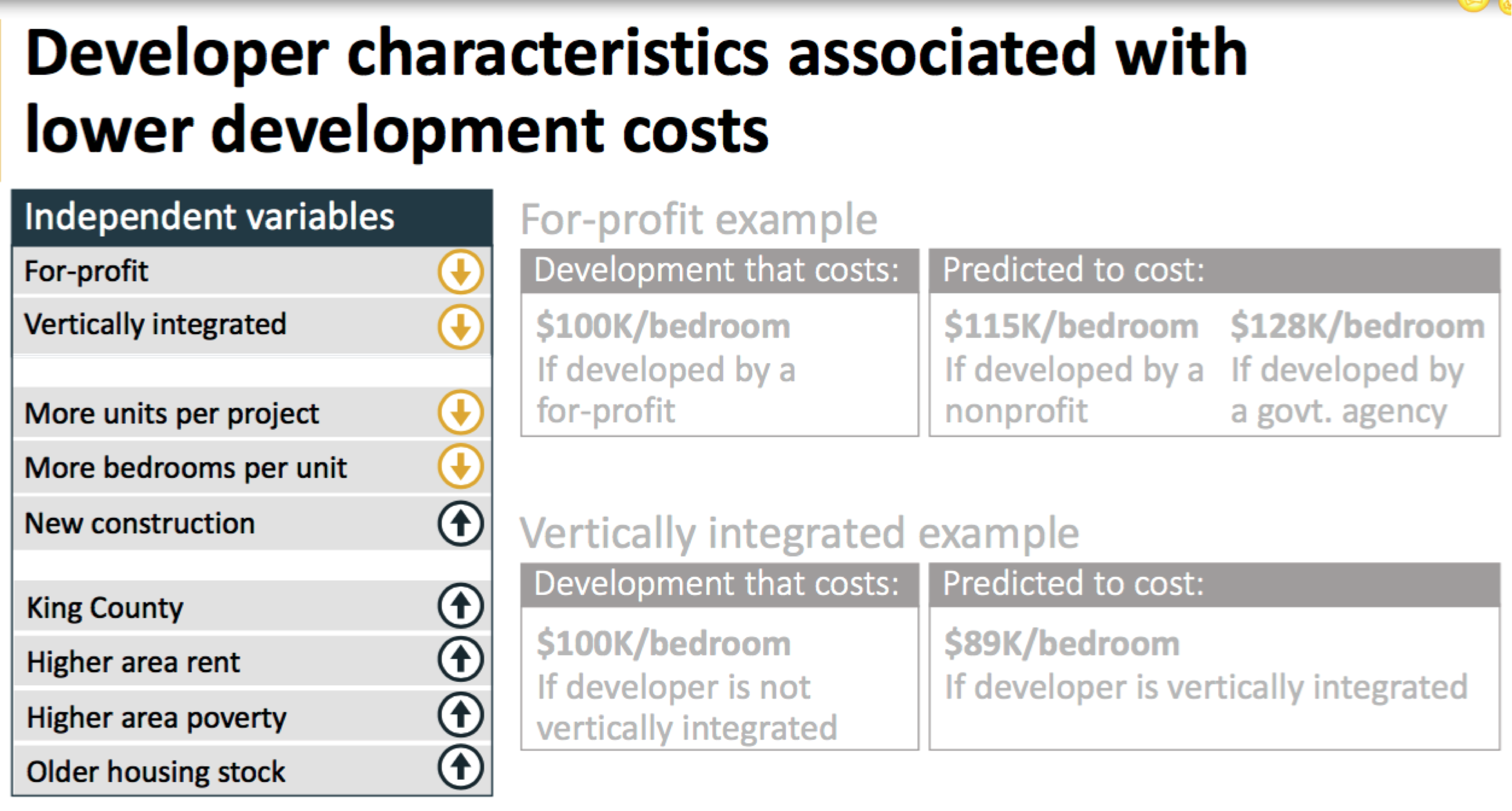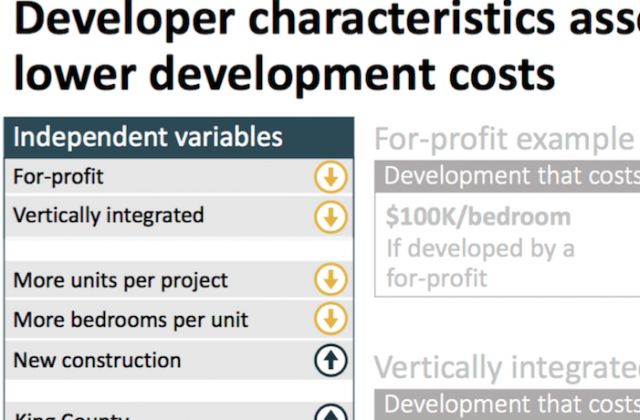Comments to the Legislature on JLARC Findings
Last week we sent the legislature these comments on the findings and recommendations of the Joint Legislative Audit and Review Committee’s (JLARC) analysis of housing costs across the non-profit and for-profit sectors. The JLARC review was precipitated by language in the 2017 Washington State operating budget we requested. I’ve written about the results but I’ve heard this letter has been helpful to pull apart what might be important in the findings.
Dear Honorable Members of the Committee,
Seattle For Growth is a non-profit advocacy organization that seeks policies and programs that create more housing of all types in all parts of our state for people of all levels of income. In 2017 we supported the passage of a budget proviso, subsequently vetoed by Governor Inslee, to have the Joint Legislative Audit and Review Committee (JLARC) conduct an evaluation of the costs of for-profit and non-profit housing. We appreciate that this work was done anyway and would like to give you preliminary comments on the findings.
It is important to note that the study found that, indeed, non-profit housing is more costly than for-profit housing. While the projects compared were limited to Low Income Housing Tax Credit (LIHTC) projects, non-profits are producing housing less efficiently (fewer units for the money) than for-profit developers. As was pointed out, this is an “apples to apples” comparison of projects.
Our criticism of the inefficiency of non-profit housing has never been about operating costs for services or been based on any deliberate wastefulness on the part of non-profit developers. Rather, we have always maintained that, as the study pointed out, building housing is complicated with many rules and regulations with even more applying to subsidized housing. Reducing and eliminating these regulatory barriers across the whole housing economy would mean lower prices, less demand for subsidies, and more efficient application of those subsidies to those most in need. This kind of efficiency is compassionate, expanding housing opportunity for all.
We agree with the three recommendations made by the JLARC team.
- Washington State Housing Finance Commission should identify and evaluate options for increasing the involvement of for-profit developers and report findings.
Many for-profit developers have recognized the higher costs associated with non-profit housing and have expressed an interest in partnering with local jurisdictions, non-profit developers, and even building housing for lease or sale to non-profits to operate that housing. The legislature should explore the barriers to allowing this collaboration to get started and encourage innovation in modular solutions and smaller unit sizes.
- Department of Commerce should collect final development cost data from Housing Trust Fund recipients to improve cost controls.
We agree with this recommendation. However, it was never our contention that the problem with non-profit costs was associated with cost overruns or even mismanagement of contractors or expenses.
Rather, we noticed growing costs across the whole housing sector for materials, labor, and those caused by permitting delays and regulation. These seemed to be even higher for non-profit projects. While the cost estimating exercise was helpful to eliminate overruns or costs accounting problems as an issue in overall costs, we never thought that was an issue.
The problem of costs continues to be that when total number of units is divided by the total development cost, a common way of reporting costs by the Washington State Housing Finance Commission (Commission) and the Commerce Department (Commerce) those per unit costs are much higher than what we found in for-profit projects. Cost estimation does not reveal why the costs are higher, just that the projects came in close to what they were budgeted to be, even if those budgets are too high to begin with.
- Both Commerce and the Commission should report development cost data to the Legislature annually.
We support this and have supported legislation offered last session that would have required this including a review of allocation of Housing Trust Fund (HTF) resources to urban and rural counties. Rural counties with higher needs are still not getting funding and this needs to be tracked and reviewed with an eye toward correcting this glaring disparity.
We offered to provide data from for-profit projects to support a comparison of for-profit developments and comparable non-profit developments. We have completed our own analysis of this data and we’ll share this before the session begins.
Slide 18 in today’s presentation is very important. I’ll include it here.

We also found that for-profit projects were substantially less costly to build than non-profit projects in our review of projects in the city of Seattle. And we also found that unit size may be an important factor. Here’s why.
When neighborhoods become more desirable because they are transit and amenity rich, two things happen. First, land becomes more expensive and so does per unit cost. While the JLARC study excluded land cost, we found that a second thing happens: renters in the market for housing are willing to sacrifice square footage for lower rents and proximity to amenities and transportation. These two factors drive down unit size, monthly rents, and increase the per square foot yield of projects for developers.
Even if land is subtracted from consideration of total development cost, for-profit projects are likely to create more, smaller units to create more competitive rents. This also means that when total development cost is divided by number of units, the cost per unit will be less. This size incentive is absent for both the producer and consumer of subsidized non-profit housing.
It is worth exploring further whether the price signals in the market are motivating efficiency in for-profit development while the lack of those signals is causing non-profits not to create more, smaller units in their projects.
Even if non-profits are building more 2 and 3 bedroom projects, if those units were incrementally smaller, allowing more units per project, more people could be housed for less cost per unit that larger units.
We appreciate the work of the JLARC team and believe this is a helpful step in creating fair and efficient programs to help people who need housing and to increase housing supply and access across the state. We look forward to working with you in 2019 to get closer to this goal.
Roger—
Articles:
Smaller Units Mean More Efficiency And Affordability If Local Government Allows Them
A Principled Way Out Of The Housing Crisis: Allow More Housing!
Washington State’s Housing Funds Aren’t Reaching Rural Workers Most In Need



